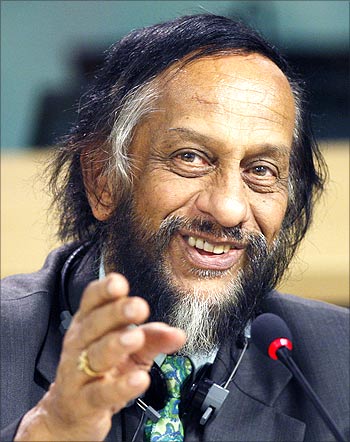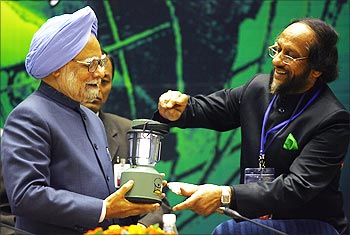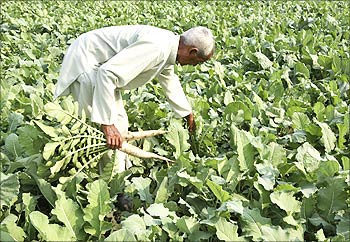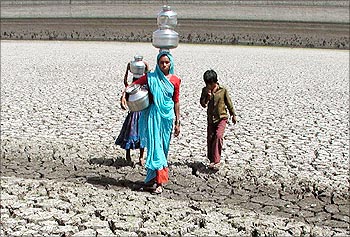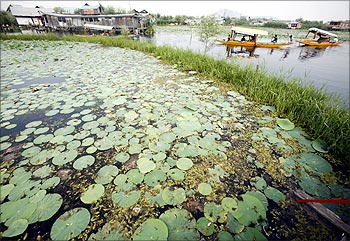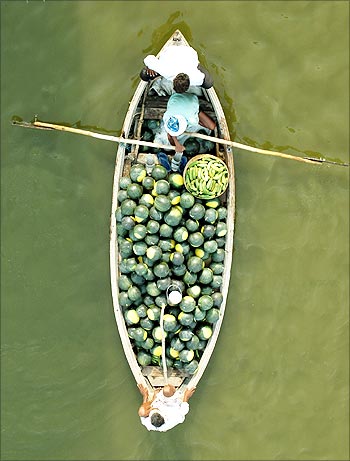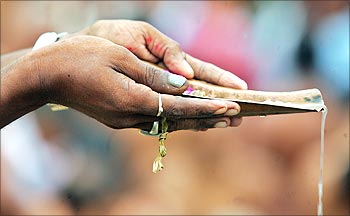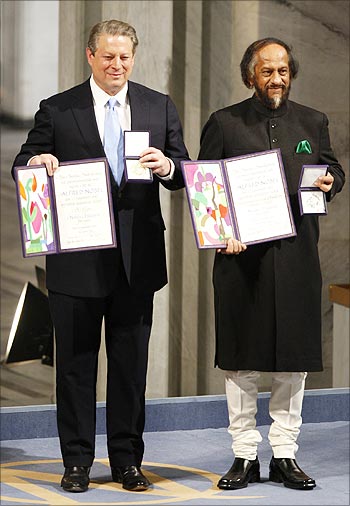 | « Back to article | Print this article |
How Teri plans to commercialise its technologies
Banwari Lal has a problem with the numbers. He holds a PhD in microbiology and six or seven patents jointly with The Energy and Resources Institute (Teri), but he can't seem to figure out what will Teri's share of the profits be if it wins -- it is one of the 60 bidders globally -- a Kuwaiti government contract to clean up its oil spills.
Along with a local partner who has a 40 per cent share, the contract will be executed by ONGC-Teri Biotech, a 49:48 joint venture whose CEO is Lal (he also heads the Environmental and Industrial Biotechnology Division of Teri).
Lal can tell you that if successful, ONGC-Teri Biotech will need to buy 'two or three shiploads of bacteria, or around 10,000 tonne, from Teri', but he can't tell you how profitable it will be.
He knows, though, that Teri will have to expand its bioreactor capacity at Gual Pahari in Gurgaon near Delhi by "at least 100 times". Lal is confident Teri will get at least some part of the project since, in his view, it is the only organisation that has developed microbes strong enough to survive in the extreme cold and heat of the desert as well as its extreme salinity that, at 7 or 8 per cent, is three times that of sea water.
The project involves cleaning up an 80x80 km area in Kuwait and is likely to cost around $3 billion. That's right, three billion dollars!
Kuwait got this money from the United Nations as compensation after Iraq damaged its wells in the first Gulf War. The contract will be awarded in January. Click NEXT to check out the story of the new TERI. . .
How Teri plans to commercialise its technologies
Most people associate Teri with policy gyaan and the Nobel Prize the Intergovernmental Panel on Climate Change headed by its director general, Rajendra K Pachauri, received for its work on climate change.
Pachauri, in fact, came in for a lot of flak from fellow environmentalists when he, like Environment Minister Jairam Ramesh, suggested that India needed to move beyond the Kyoto framework and take on some non-binding emission-cut commitments.
Pachauri, of course, will have to focus hard on the Copenhagen meet on climate change and the events after that. But he will be no less focused on the news from Kuwait. This is the new side of Teri.
So why is a think tank whose annual budget is around Rs 120 crore (Rs 1.20 billion) bidding for a technical project in Kuwait? Is this a strategic diversification into a global market for environmental products and services, which, says a report on the Teri website, is likely to double from $1.37 trillion now to $2.74 trillion by 2020?
Pachauri, understandably, doesn't want to get into numbers until there is some clarity on the Kuwait situation in January, but he says Teri was always meant to do applied research.
"When Darbari Seth (of Tata Chemicals) founded it in 1974, he wanted it to find solutions to energy efficiency . . . Don't forget, he transported tonnes of coal all the way to Mithapur (in Gujarat) and so wanted a solution to this problem . . . In the early days, Teri functioned as a documentation centre and supplied information on various issues like energy saving . . . "
How Teri plans to commercialise its technologies
So while Teri worked on policy issues -- it started working on climate change in 1989, seven years after Pachauri joined as its head -- a biofuels programme was in place by 1985.
Reinforcing policy goals
How will Teri change if it wins the Kuwait contract?
Pachauri chooses instead to talk about the other projects -- the Lighting a Billion Lives project where, for instance, Teri has brought the cost of a solar lamp including the recharging facility down to Rs 2,200 apiece and is running pilots where women give lamps on rent during the night and recharge them during the day.
The idea, he suggests, is to get the consulting and commercial part of Teri's work to reinforce its policy goals of a lower carbon-footprint growth model -- today, roughly a third of Teri's annual budget comes from either royalties or share of profits from joint ventures like ONGC-Teri Biotech or from commercial projects like the 20 to 30 energy audits it does each year and the licensing fees from its gassifier projects.
The policy work of the Copenhagen type, Pachauri says, occupies 35 to 40 per cent of Teri's divisions; the rest are all focussed on project work.
To understand the excitement at Teri, say this slowly since this is at the heart of most things Teri does right now: M-Y-C-O-R-I-Z-E-R. Spelt mycorrhiza, it is a microbe that feeds on oil and other substances, and converts them into proteins.
The initial research on using microbes to clean oil spills took six years and was funded by the Department of Biotechnology. Lal's job was to find microbes which were ideally suited for the conversion process -- in the Kuwait case where Lal went and collected 500 microbes to bring back to his laboratory to test, he found 99 per cent were "lazy and didn't degrade" . . . so the trick was to find the right one and design a "nutrient recipe" that allowed the microbes to digest the oil and convert it into protein.
How Teri plans to commercialise its technologies
What worked well in the labs, however, needed to be scaled up at the field level. So, around 1994, Lal went back to the Department of Biotechnology and asked for more funds after the initial grant of Rs 20 lakh (Rs 2 million).
The department felt it was best he approached industry and Lal went with his microbes to ONGC.
ONGC, he learnt, paid lakhs each year to farmers whose farms were damaged each time an oil pipeline got punctured -- since the oil spills meant the fields lay fallow for up to four years, the compensation was huge.
Enter mycorrhiza, and, within months, the fields were cleared of the oil and the resultant protein -- once the oil is cleaned up, the microbes can't find any more food and die, leaving the soil protein-enriched -- ensured the land was more fertile than before.
After this, Indian Oil Corporation tested the microbes at its Mathura refinery to clear oil spills as well as to clean the tanks where the sludge from the storage tanks used to be dumped.
How Teri plans to commercialise its technologies
Today, 14 or 15 of India's 17 refineries use these microbes. A total of 130,000 tonnes of oily sludge or soil contaminated with oil has been treated with Teri's Oilzapper since 1997.
Commercialising technology
Another mycorrhiza produces acids and surfactants that help in increasing oil recovery from fields -- along with the gas the microbes produce, this helps release the oil from rock formations and even increases the pressure in the field which is vital for oil extraction.
For those not convinced, Lal reminds you of how the stomach swells each time you have an infection due to microbes and, for the really macabre, he points to the fact that dead bodies swell up due to microbial reactions.
This is being used in several ONGC installations -- a total of 50 wells in Mahesana and Ahmedabad have used this microbial enhanced oil recovery. And it is being used in another 100 at the moment. It has helped recover around 44,000 tonne of additional oil so far.
At the then crude oil prices, this adds up to revenue of around Rs 74 crore (Rs 740 million). While ONGC-Teri Biotech is commercialising the technology -- it earned Rs 40 crore (Rs 400 million) last year, made a profit of Rs 3 crore (Rs 30 million) and paid taxes of Rs 1 crore (Rs 10 million) -- another joint venture has been signed with Global Technology Investors in the US.
How Teri plans to commercialise its technologies
Glori Oil is based in Houston and has applied microbial enhanced oil recovery in 25 wells. The technology, it appears, can also be used to make crude oil less waxy, perhaps something Cairn India CEO Rahul Dhir, who is on Teri's advisory board, will be able to vouch for if he uses this in his Barmer oil fields where evacuating the waxy crude is proving to be an expensive proposition. ONGC has used Teri's paraffin-degrading microbes in 100 wells already.
If Lal has got two joint ventures to help Teri make money, his neighbour Alok Adholeya (he has been with Teri for 23 years as compared to Lal's 21) has five licensees doing the same.
Adholeya, who received his PhD from Govind Ballabh Pant University, heads the Biotechnology and Bioresources Division. He says his brief after he joined Teri was to create a bank of microbes that could help plants grow better.
At 500 or so, he claims to have the largest collection of such cultures in the world. Teri's bio-fertilisers, according to Adholeya, are being used in around 1,000 hectares of land at the moment and help reduce fertiliser usage by 25 to 30 per cent -- a pilot in Qatar grew vegetables in the desert and Teri is in talks with Kuwaiti authorities to do the same thing there once "Lal cleans up".
Other microbes, Pachauri says, help pull up nutrients that are otherwise not reachable by plants in desert areas. A Teri tissue culture centre has dispatched around 18 million plants to farmers in different regions.
How Teri plans to commercialise its technologies
Teri gets a 5 per cent royalty on all purchases and Rs 25 lakh (Rs 2.5 million) in technology-transfer fee. Different species of mycorrhiza, Adholeya says, are being used to clean up ash ponds in thermal power plants, distilleries and so on.
Talks are on with various mining companies to use the bio-mining microbes (this helps get the minerals out without damaging the environment). A joint venture for jatropha cultivation has been set up with a German company after an R&D project with British Petroleum on jatropha ended.
Saving carbon emissions
Another eight companies have been licensed to sell or implement Teri's biomass gassifiers which convert plant and wood residue to gas that drives an alternator to produce electricity.
If an Australian government-funded project to develop a solar biomass-based cooling system works out, this too will convert into a series of licences. Eighty to 90 glass units in Firozabad near Agra use Teri's pot furnace and several brick kilns use its vertical shaft brick kiln.
According to Teri, its technologies helped the medium- and small-scale sector save around 350,000 tonnes of carbon emissions last year.
How Teri plans to commercialise its technologies
A books division has a turnover that's already up to Rs 4 crore (Rs 40 million) doing children's and other books. It plans to do college textbooks by next year and the 'Soldiers of the Earth' global environment programme has actor Akshay Kumar offering ideas for attractive comic books.
Whatever the outcome of the Kuwait project, with so many commercial projects coming out of its R&D work on a regular basis, it is clear Teri is no longer your run-of-the-mill, though successful, policy institute.
It already has centres in the United States, the United Kingdom, Japan and the United Arab Emirates. In India, it has a centre over 36.5 hectares in Gurgaon, another one in Mukteshwar in the Himalyas, a campus in Goa and Bangalore and a Teri University in Vasant Kunj in south Delhi.
How Teri will manage the transition to Teri Inc will be interesting to watch. It also holds the key to how India's laboratories and research institutes can refashion their operations.
